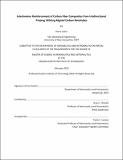| dc.contributor.advisor | Brian L. Wardle. | en_US |
| dc.contributor.author | Lewis, Diana J. (Diana Jean) | en_US |
| dc.contributor.other | Massachusetts Institute of Technology. Department of Aeronautics and Astronautics. | en_US |
| dc.date.accessioned | 2017-01-30T18:50:15Z | |
| dc.date.available | 2017-01-30T18:50:15Z | |
| dc.date.copyright | 2016 | en_US |
| dc.date.issued | 2016 | en_US |
| dc.identifier.uri | http://hdl.handle.net/1721.1/106679 | |
| dc.description | Thesis: S.M., Massachusetts Institute of Technology, Department of Aeronautics and Astronautics, 2016. | en_US |
| dc.description | This electronic version was submitted by the student author. The certified thesis is available in the Institute Archives and Special Collections. | en_US |
| dc.description | Cataloged from student-submitted PDF version of thesis. | en_US |
| dc.description | Includes bibliographical references (pages 113-119). | en_US |
| dc.description.abstract | Advanced laminated composites suffer from a lack of out-of-plane strength and toughness, leading to delamination and other types of interlaminar failure. Aligned carbon nanotubes (A-CNTs) placed at the interlayer between plies of an aerospace grade carbon fiber reinforced plastic composite (CFRP) have been shown to increase interlaminar toughness while improving laminate strength. While this architecture, known as 'nanostitch', has proven beneficial, morphological changes in the A-CNT layer and their effect on the composite properties has not been studied. This thesis explores the effect of varying the A-CNT height and the layup technique on the resulting interlaminar region morphology and static short beam strength (SBS) in shear, of a quasi-isotropic layup using Hexcel IM7/8552 carbon fiber aerospace composite prepreg. In addition, fatigue testing was performed on a selected A-CNT height to generate a SBS fatigue life curve. Interface morphology and laminate damage were imaged via optical and scanning electron microscopy of cross-sections and crack surfaces, and micro-computed tomography was used to generate 3D reconstructions of some coupons. Results from static testing indicate that the A-CNT reinforcement of the interlaminar region increase the SBS by 8.5%, regardless of height (in the 5-65 micron range studied) or the two different layup techniques. This indifference to forest morphology is attributed to damage primarily occurring outside of the reinforced area, indicating that the interlaminar region is sufficiently reinforced by all A-CNT heights considered. Fatigue-life data shows a threefold increase in lifespan for the A-CNT reinforced material. All A-CNT forests affected the interface morphology, increasing the average interlayer thickness by inducing resin agglomerations near the CNT layer. This agglomeration results from resin-rich defects in the original prepreg material. Ancillary tasks involved in generating this thesis included inventing a method of measuring A-CNT forest height using an optical microscope, introducing water into the CNT growth process and controlling the furnace starting temperature to stabilize the height, altering the layup method to generate desired morphologies, and proposing a 'hot-load' system for the furnace to increase the CNT forest production tenfold. | en_US |
| dc.description.statementofresponsibility | by Diana Lewis. | en_US |
| dc.format.extent | 119 pages | en_US |
| dc.language.iso | eng | en_US |
| dc.publisher | Massachusetts Institute of Technology | en_US |
| dc.rights | MIT theses are protected by copyright. They may be viewed, downloaded, or printed from this source but further reproduction or distribution in any format is prohibited without written permission. | en_US |
| dc.rights.uri | http://dspace.mit.edu/handle/1721.1/7582 | en_US |
| dc.subject | Aeronautics and Astronautics. | en_US |
| dc.title | Interlaminar reinforcement of carbon fiber composites from unidirectional prepreg utilizing aligned carbon nanotubes | en_US |
| dc.type | Thesis | en_US |
| dc.description.degree | S.M. | en_US |
| dc.contributor.department | Massachusetts Institute of Technology. Department of Aeronautics and Astronautics | en_US |
| dc.identifier.oclc | 969127954 | en_US |
